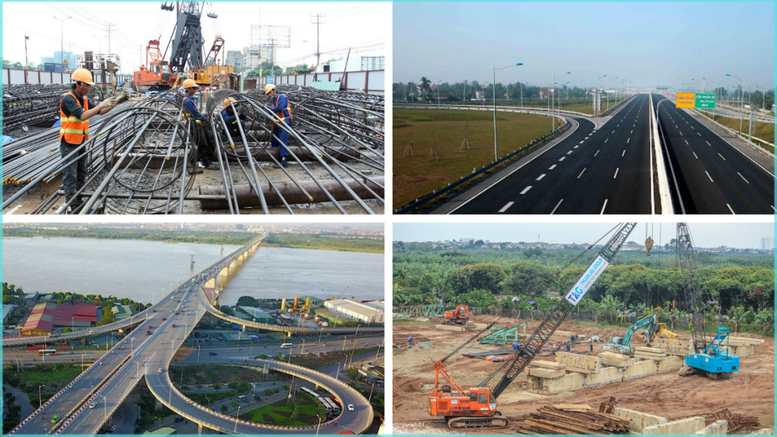
On numerous occasions, the Prime Minister has been present at construction sites from early morning or in the middle of the night, working through holidays to resolve difficulties and obstacles right on the site, and demanding the complete disbursement of public investment funds according to plan.
Understanding this importance very well, from the beginning of his term, Prime Minister Pham Minh Chinh directly supervised, urged, and inspected numerous key public investment projects nationwide. On many occasions, the Prime Minister was present at construction sites from early morning or late at night, working through holidays to resolve difficulties and obstacles on-site, and demanding the complete disbursement of public investment funds according to plan. The political determination is very clear – but to realize the development goals, the Prime Minister and the Government need a supporting institution: a transparent, flexible, and effective Public Investment Law.
Currently, the Government has submitted to the 9th Session of the 15th National Assembly a law amending several laws in the fields of investment, finance, and budget, including the Law on Public Investment.
In fact, the current Law on Public Investment has created a relatively complete and rigorous legal framework for the planning, appraisal, approval, and supervision of investments using state budget funds. Thanks to the Law, fiscal discipline and the efficiency of public investment use have been gradually improved, limiting the situation of scattered, fragmented investments and losses. Many important principles such as transparency, decentralization of responsibility, and social supervision have been institutionalized, contributing to strengthening public investment governance throughout the system.
However, in the context of new developments – with the need for rapid economic recovery, promoting digital transformation, large-scale infrastructure investment, and attracting private resources – the limitations on flexibility, compatibility, and consistency in the implementation of the Public Investment Law are becoming increasingly apparent. Therefore, reforming the Public Investment Law is not intended to negate existing achievements, but rather to improve the institutional framework and remove bottlenecks we are facing, meeting practical requirements.
Major bottlenecks in the Public Investment Law
One of the most common complaints is that the public investment process is too multi-layered, lacking integration and flexibility. From formulating investment policies, appraising and approving projects, allocating medium-term and annual capital plans, and then adjusting capital plans – each stage requires seeking opinions, submitting to competent authorities, and supplementing documents according to different forms. Many agencies are involved, leading to overlapping responsibilities, delays, and unclear accountability. The consequence is missed investment opportunities, delayed project commencement, and significantly reduced capital utilization efficiency.
The phenomenon of "money sitting idle in the treasury" is no longer a localized issue but has become a chronic problem, recurring for many consecutive years. The consequences include delays in many infrastructure projects, cost overruns, missed growth opportunities, and, most importantly, a erosion of trust in government policies.
When a project is hampered by obstacles preventing disbursement – due to land acquisition issues, design documents, or bidding procedures – transferring funds to another project is also difficult because the law is too strict. This creates a "bottleneck" effect: a small bottleneck can stall the entire public investment plan of a sector, locality, or even the entire fiscal year.
Although the 2020 PPP Law established a separate legal framework for public-private partnership projects, when state capital is used to support construction, this capital must still be implemented according to the procedures of the Public Investment Law. According to Clause 5, Article 70 of the PPP Law, state capital is managed as a separate sub-project or item and is subject to the full regulations of the public investment law.
The simultaneous application of both the PPP Law and the Public Investment Law makes project implementation procedures complex, lengthy, and inflexible – contrary to the characteristics of the PPP model. This increases legal risks, creates apprehension among the private sector, and affects the ability to mobilize non-budgetary capital. To overcome this, it is necessary to review and adjust the coordination mechanism between the two laws in a way that is clear, streamlined, and convenient for implementation.
The law imposes quite heavy legal liability, but lacks clarity on evaluation criteria or principles for handling errors. This leads to anxiety and fear of being accused of wrongdoing during implementation, even if it's just a technical or procedural error. In the context of incomplete laws and inconsistent guidelines, many officials choose "it's better not to do it than to make a mistake." Personal safety outweighs the motivation to act for work efficiency.

New public investment is a driving force for development.
The root causes of institutional blockage
The bottlenecks in the implementation of the Public Investment Law are not only a consequence of a lack of uniformity in implementation guidelines or the capacity of local officials, but stem from core issues in legislative thinking, institutional design, and risk management approaches in the public sector.
The Public Investment Law was drafted in the context of tightening discipline and preventing losses, so the main thinking is to control inputs rather than promote outputs. Each process and procedure is designed as a layer of protection against wrongdoing, but inadvertently becomes a barrier that slows down the entire system. As a result, instead of creating a mechanism to encourage innovation and bold action, the Law encourages a mentality of safety and avoidance.
Although the Public Investment Law has classified projects into groups A, B, and C with corresponding procedures, in practice, this distinction mainly only extends to the level of investment decision-making authority, appraisal time, and approval procedures, and has not yet resulted in a clearly differentiated system of administrative procedures, monitoring mechanisms, or governance models. Many procedures are still applied relatively uniformly, causing some small-scale, low-risk projects to go through cumbersome processes, wasting time and resources. This shows that the Law still lacks a sophisticated risk management mechanism, which is a core element in modern public investment management models in many developed countries.
Although the Law stipulates the principle of decentralization, in practice, decision-making authority remains concentrated at the central level, especially in areas such as adjusting capital plans, changing investment policies, or approving project lists. Local authorities are merely implementing units, but are constrained by a process based on requests and approvals. Assigning tasks without granting sufficient authority and tools for adjustment prevents local officials from proactively addressing practical difficulties, leading to passivity and dependence.
Currently, control over public investment still focuses primarily on the initial stages – approval, appraisal, and acceptance – while the later stages, such as implementation, acceptance, and effectiveness evaluation, lack a sufficiently strong and independent monitoring mechanism. The monitoring system relies on human resources and paper documents, lacking the application of technology and digital data. This neither helps prevent violations in practice nor creates excessive pressure at the initial stage, slowing down the entire investment implementation process.
Based on the core reasons mentioned above, it is clear that amending the Law on Public Investment is not merely a technical adjustment, but requires a comprehensive reform mindset – shifting from the old-style rule of law to modern governance, placing efficiency and results at the center.

For public investment to truly become a driver of growth, rather than a hindrance to development, a fundamental institutional reform is needed.
A radical reform solution in accordance with international standards.
For public investment to truly become a growth engine, rather than a hindrance, Vietnam needs fundamental institutional reforms, not just technical fixes. These reforms must be based on four core principles of modern public governance: empowerment, accountability, intelligent oversight, and a focus on results . Specifically:
First, it is necessary to streamline and integrate the fragmented procedures. The steps of policy formulation, project appraisal, approval, and funding allocation should be consolidated into a single, continuous process, instead of being divided into multiple layers as is currently the case.
In particular, it is necessary to apply the "rolling plan" model – a common international practice – instead of just fixed 5-year and annual plans. (This is an investment plan that is reviewed, updated, and adjusted periodically (annually or quarterly) , based on the approved medium-term plan , instead of being completed once and then "fixed" for 5 years). Thanks to this, projects can be updated flexibly when conditions are ripe, avoiding the time wasted waiting for a new planning phase.
We need to move away from the "one shoe size fits all" mindset – and instead, build a procedural system based on risk classification and investment scale. Small, low-risk projects (e.g., renovation of commune-level facilities, urban infrastructure, etc.) should apply streamlined procedures and delegate more authority to local governments. Large, high-risk projects require stricter procedures, independent appraisal, and public disclosure of information for public oversight.
This approach not only saves time and resources, but also focuses control on the areas of high risk – consistent with the "risk-based governance" principle widely adopted by OECD countries.
We must shift from "formal decentralization" to "substantive decentralization." Local authorities and ministries should be able to decide on adjustments to capital plans within their assigned scope, instead of having to seek central government approval for every minor change.
In addition, a "responsibility contract" model should be applied between the central and local governments – in which delegation of authority goes hand in hand with individualized responsibility. Those who fail to meet disbursement deadlines must be evaluated and penalized based on output results, instead of blaming the process.
Currently, the state capital portion in PPP projects is still subject to the full procedures of the Public Investment Law, leading to cumbersome and lengthy procedures and reducing flexibility – a core strength of the PPP model. Therefore, it is necessary to limit the scope of application of the Public Investment Law to only the public capital portion, not extending it to the entire project, while simplifying administrative procedures and ensuring harmony between the two laws through interconnected guidelines or appropriate amendments. This solution will contribute to unlocking private resources, promoting infrastructure investment, and enhancing the effectiveness of public-private partnerships.
The effectiveness of investment lies not in the review of documents, but in the final results on the ground. An independent post-audit system is needed – evaluating the actual effectiveness of the project after completion and publicly disclosing the results to create pressure from society.
Instead of piling up pre-approval processes, let local authorities take the initiative and be accountable for the results, similar to the models adopted in New Zealand and Canada.
Finally – and fundamentally – the entire ecosystem must be digitized. Public investment. An integrated data system (dashboard) needs to be established at the national level, connecting the State Treasury, the Ministry of Finance, local authorities, and investors.
Information on progress, disbursement, obstacles, and output effectiveness needs to be updated in real time and publicly available on digital platforms. This is not only a smart monitoring tool, but also a remedy against the fear of responsibility, because everything is transparent.
An institutional revolution is needed in public investment.
Revising the Law on Public Investment should not only be a technical adjustment, but also an institutional revolution – shifting from a control-oriented mindset to a proactive one.
To achieve this, the Public Investment Law needs to be redesigned according to modern governance principles: empowerment – accountability – intelligent oversight – focus on output results. Only then will public investment truly become a driving force for development, instead of the bottlenecks it currently faces.
Dr. Nguyen Si Dung
Source: https://baochinhphu.vn/nhung-nut-that-can-thao-go-trong-dau-tu-cong-102250523061713674.htm







![[Photo] Prime Minister Pham Minh Chinh presides over a meeting on private sector economic development.](/_next/image?url=https%3A%2F%2Fvphoto.vietnam.vn%2Fthumb%2F1200x675%2Fvietnam%2Fresource%2FIMAGE%2F2025%2F12%2F20%2F1766237501876_thiet-ke-chua-co-ten-40-png.webp&w=3840&q=75)





























































































Comment (0)